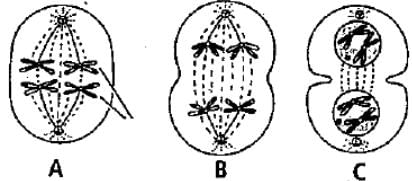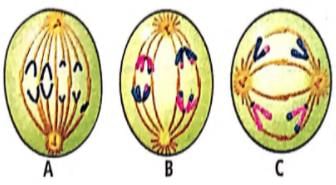Test: Meiosis (NCERT) - NEET MCQ
20 Questions MCQ Test NCERTs at Fingertips: Textbooks, Tests & Solutions - Test: Meiosis (NCERT)
To build up food reserves in the cytoplasm, chromosomes become unfolded to start transcription of mRNA and rRNA, during which phase of meiosis I?
At which of the following stages, the chromosomes appear single, thin and thread like?
Assertion (A): During mitosis, the chromosome number of the daughter cells is the same as that of the parent cell.
Reason (R): Mitosis involves a single round of DNA replication followed by a single cell division.
Which of the following is a characteristic feature of telophase?
Identify the given figures showing meiotic phases and select the correct option.

An anther has 1200 pollen grain. How many PMCs must have been there to produce them?
If 2n = 4, then identify the figures A, B and C, as per the following codes and select the correct option.

Anaphase of meiosis I = (i)
Anaphase of mitosis = (ii)
Anaphase of meiosis II = (iii)
During meiosis - I in humans, one of the daughter cells receives
During which phase of the cell cycle does the cell prepare for mitotic division by rapidly growing and synthesizing a wide range of proteins?
Four different steps that occur during meiosis are given in the following list.
(i) Complete separation of chromatids
(ii) Pairing of homologous chromosomes
(iii) Lining up of paired chromosomes on equator
(iv) Crossing over between chromatids
Select the correct sequential arrangement of the steps.
Which phase of mitosis is characterized by the alignment of chromosomes at the cell's equator?
At what phase of meiosis there are two cells, each with separated sister chromatids that have been moved to opposite spindle poles?
|
257 docs|234 tests
|





















